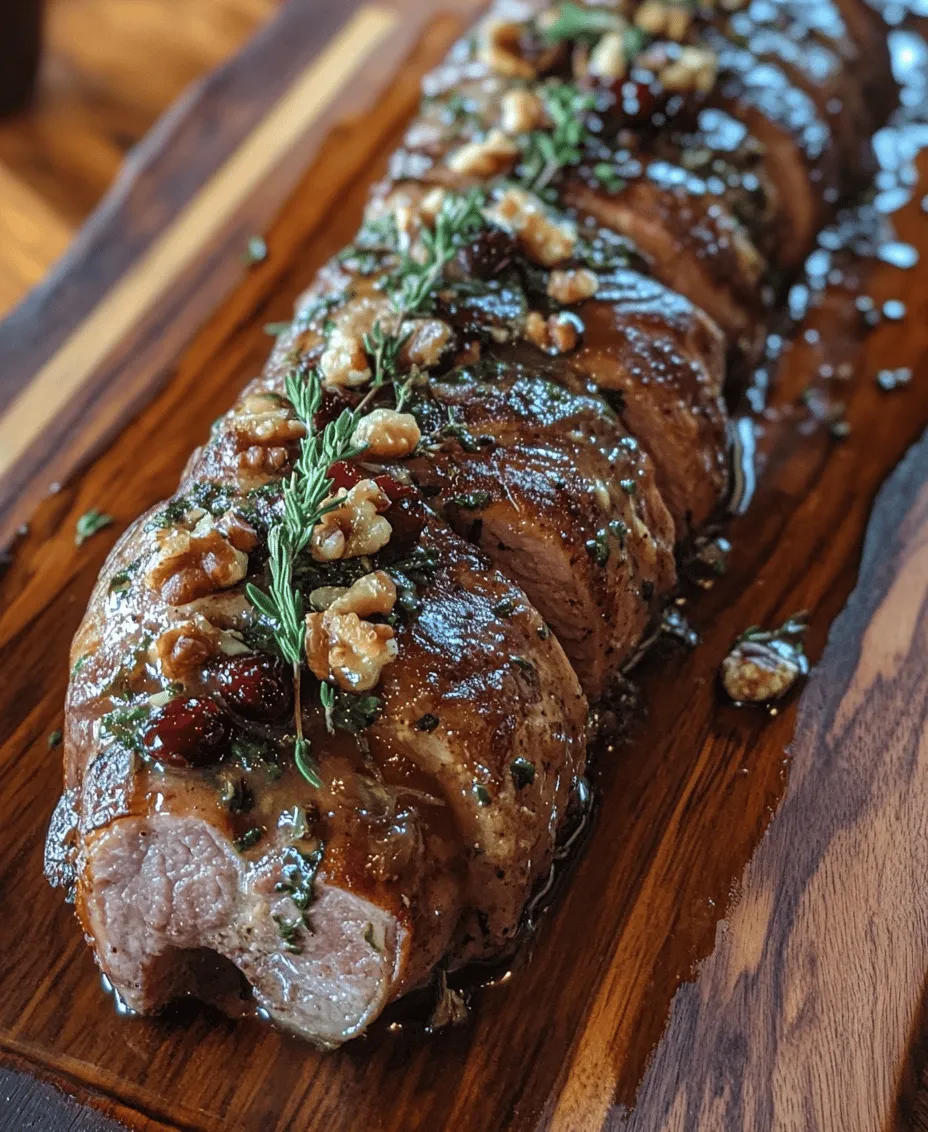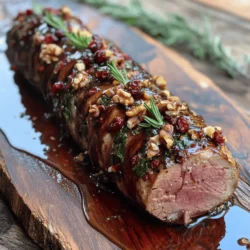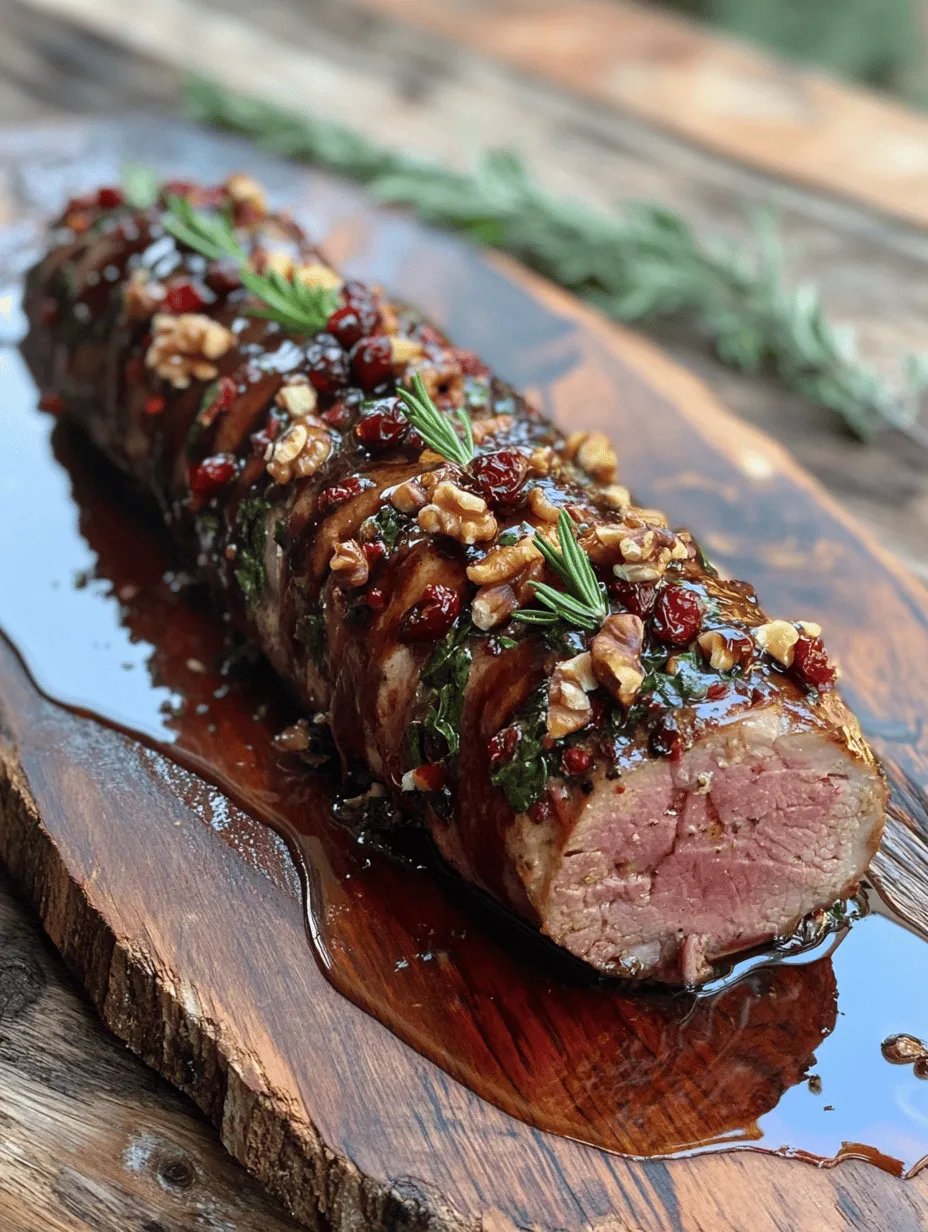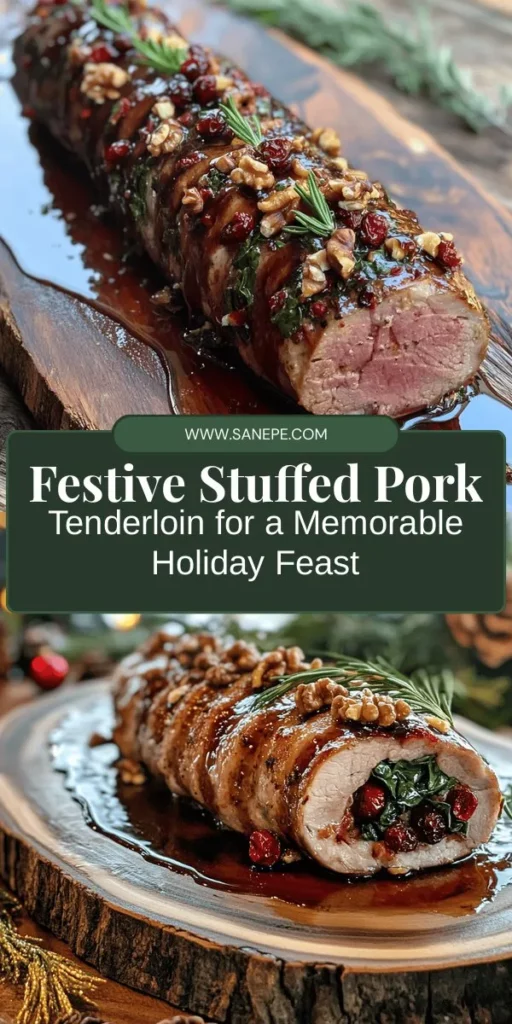Introduction
As the holiday season approaches, kitchens around the world come alive with the aromas of festive cooking. This time of year is not just about the gifts and decorations; it is a celebration of togetherness, tradition, and, most importantly, delicious food. Families gather around the dinner table, sharing stories and laughter while enjoying meals that have often been passed down through generations. The centerpiece of these gatherings is often a beautifully prepared dish that reflects the warmth and joy of the holidays.
One such dish that encapsulates the spirit of Christmas is the Flavorful Christmas Stuffed Pork Tenderloin. This elegant yet approachable recipe is a true feast for the senses, combining savory pork with a medley of festive flavors. The succulent pork tenderloin is expertly stuffed with a delightful mixture of spinach, dried cranberries, walnuts, and fresh herbs, creating a harmonious blend of taste and texture that is sure to impress your guests. Whether you’re hosting a holiday dinner or contributing to a family feast, this stuffed pork tenderloin not only satisfies the palate but also adds a touch of sophistication to your table.
When it comes to holiday cooking, the importance of a well-prepared dish cannot be overstated. A thoughtfully crafted meal can elevate the gathering, creating lasting memories for all who partake. The Christmas Stuffed Pork Tenderloin is more than just a dish; it is a symbol of celebration and togetherness, making it the perfect choice for your festive spread.
Understanding Pork Tenderloin
Before diving into the specifics of this delightful recipe, it’s essential to understand the star of the show: pork tenderloin. This cut of meat is known for its incredible tenderness and mild flavor, which makes it a versatile choice for a variety of culinary applications. Pork tenderloin comes from the muscle that runs along the backbone of the pig, resulting in a buttery texture that practically melts in your mouth when cooked properly.
One of the key characteristics of pork tenderloin is its lean composition. Unlike other cuts of pork, it has a lower fat content, making it a healthier option for those looking to enjoy a hearty meal without the added calories. In addition to being a lean source of protein, pork tenderloin is rich in essential vitamins and minerals, including B vitamins, zinc, and phosphorus. These nutrients contribute to overall health, supporting functions such as energy metabolism and immune health.
Choosing pork tenderloin for your festive meals is not only a nod to its nutritional benefits but also a celebration of its adaptability. It can be marinated, grilled, roasted, or stuffed, allowing home cooks to explore various flavor profiles and cooking techniques. This versatility, paired with its impressive presentation, makes pork tenderloin a fantastic choice for holiday gatherings where you want to leave a lasting impression.
Ingredients Breakdown
Now that we’ve established the significance of pork tenderloin, let’s delve into the ingredients that make this recipe a festive delight. The following components not only enhance the flavor of the dish but also contribute to its nutritional value, ensuring that everyone enjoys a delicious and wholesome meal.
Pork Tenderloin
When selecting pork tenderloin, look for a cut that is firm to the touch, with a pinkish-red color and minimal marbling. Avoid any pork that appears discolored or has excessive fat. Freshness is key, so purchasing from a trusted butcher or grocery store is advisable. Before cooking, it’s essential to trim away any silver skin—a tough membrane that can hinder flavor absorption—using a sharp knife for the best results.
Spinach
Spinach is a nutrient-dense leafy green that adds both flavor and health benefits to the stuffing. Packed with vitamins A, C, and K, as well as iron and calcium, spinach is a powerhouse of nutrition. Its slightly earthy taste complements the sweetness of dried cranberries and the richness of walnuts, creating a balanced filling. For this recipe, use fresh spinach, as it wilts down beautifully when sautéed, allowing it to mix seamlessly with the other ingredients.
Dried Cranberries
Adding sweetness and a chewy texture, dried cranberries are an essential component of the stuffing. They provide a delightful contrast to the savory pork and the crunch of walnuts. Beyond their flavor, dried cranberries are also rich in antioxidants, which can help combat oxidative stress in the body. When choosing dried cranberries, opt for those that are unsweetened or lightly sweetened to avoid overwhelming the dish with excess sugar.
Walnuts
Walnuts contribute a satisfying crunch and creamy richness to the stuffing. They are not only delicious but also packed with healthy fats, protein, and essential nutrients such as omega-3 fatty acids, which are known to support heart health. Toasting the walnuts before adding them to the stuffing enhances their flavor and gives them an appealing crunch. Simply place them in a dry skillet over medium heat until fragrant, and then chop them coarsely for the best texture.
Fresh Herbs (Rosemary and Thyme)
Fresh herbs are the secret to elevating the flavors of any dish, and in this recipe, rosemary and thyme play a pivotal role. Rosemary brings a pine-like aroma and earthy flavor, while thyme adds a subtle hint of sweetness and warmth. Together, they create a fragrant herbaceous quality that pairs perfectly with pork. For optimal flavor, chop the herbs finely before incorporating them into the stuffing, allowing their essential oils to release and infuse the mixture.
Spices (Cinnamon, Salt, and Pepper)
The addition of spices can transform a good dish into a great one, and in this recipe, cinnamon, salt, and pepper are key players. A pinch of cinnamon adds warmth and a hint of sweetness that complements the other flavors beautifully. Salt is essential for enhancing the overall taste of the dish, while freshly cracked black pepper adds just the right amount of heat. Be sure to adjust the seasoning according to your taste preferences, ensuring a perfectly balanced stuffing.
Olive Oil
Finally, olive oil is a staple in many kitchens and serves as the perfect cooking fat for this recipe. It not only adds richness to the stuffing but also helps in sautéing the spinach and other ingredients. Olive oil is known for its health benefits, including heart-healthy monounsaturated fats and antioxidants. When selecting olive oil, opt for extra virgin for its superior flavor and quality.
With these ingredients in hand, you are well on your way to preparing a truly festive dish that will have your guests raving. In the next section, we will dive into the detailed instructions for creating this Flavorful Christmas Stuffed Pork Tenderloin, ensuring that you have all the guidance needed to make this dish a holiday success.

Chicken Broth, Balsamic Vinegar, and Honey: Their Contributions to the Sauce and Overall Dish
In our Flavorful Christmas Stuffed Pork Tenderloin Recipe, the combination of chicken broth, balsamic vinegar, and honey plays a pivotal role in enhancing the overall flavor profile and texture of the dish.
Chicken Broth serves as the base for our sauce, adding depth and richness. It not only infuses the pork with moisture but also complements the savory notes of the stuffing. The broth’s umami qualities enhance the overall taste, making each bite succulent and flavorful.
Balsamic Vinegar introduces a delightful acidity that balances the richness of the pork. Its sweet and tangy notes elevate the dish, providing a contrast that makes the flavors pop. When reduced, balsamic vinegar thickens into a syrupy glaze, enveloping the tenderloin in a glossy finish that is not only visually appealing but also enhances the flavor.
Honey, a natural sweetener, rounds off the sauce with its subtle sweetness. It works harmoniously with the vinegar, creating a perfect balance that ties the dish together. The caramelization that occurs during the cooking process brings out the best in both the honey and balsamic vinegar, creating a sauce that is both complex and satisfying.
Now that the foundational flavors have been established, let’s delve into the step-by-step preparation of this festive dish.
Step-by-Step Preparation
Preheating the Oven
Before you start with the cooking process, preheat your oven to 375°F (190°C). Preheating is crucial as it allows for even cooking, ensuring that the pork tenderloin reaches the perfect internal temperature without overcooking. An accurately preheated oven will help maintain the juices within the meat, enhancing the tenderness and flavor of each slice.
Preparing the Stuffing
To prepare the stuffing, begin by heating a tablespoon of olive oil in a large skillet over medium heat. Add the finely chopped onion and garlic, sautéing until they become translucent and fragrant. This process, known as sweating, allows the flavors to develop and infuses the oil with aromatic goodness.
Next, incorporate the chopped vegetables, such as bell peppers and mushrooms, and sauté for an additional 5-7 minutes until they are tender. The key here is to ensure that the vegetables release their moisture; this will prevent the stuffing from becoming soggy. Stir in the herbs—such as thyme, rosemary, and parsley—and season generously with salt and pepper. Once combined, remove from heat and allow the stuffing mixture to cool slightly before adding breadcrumbs and cheese.
Butterflying the Pork
Butterflying the pork tenderloin is a technique that involves slicing the tenderloin lengthwise without cutting all the way through. This creates a larger, flatter surface area that is perfect for holding the stuffing. Place the tenderloin on a cutting board, and using a sharp knife, carefully slice it down the center, stopping about half an inch from the bottom. Open it like a book, and gently pound it with a meat mallet to achieve an even thickness, which will ensure even cooking.
Stuffing and Rolling the Pork
Now it’s time to stuff the pork. Spread the sautéed stuffing mixture evenly over the butterflied pork tenderloin, leaving a small border around the edges. Carefully roll the tenderloin away from you, tucking in the sides as you go to secure the stuffing inside. Once rolled, tie the tenderloin tightly with kitchen twine to hold the shape and prevent the stuffing from spilling out during cooking.
Searing the Tenderloin
In a large oven-safe skillet, heat a tablespoon of olive oil over medium-high heat. Once the oil is shimmering, gently place the stuffed pork tenderloin seam-side down in the skillet. Sear for 3-4 minutes on each side until golden brown. This step is crucial as it creates a flavorful crust on the outside of the pork, sealing in the juices and enhancing the overall taste of the dish.
Roasting Process
After searing, transfer the skillet to your preheated oven. Roast the pork tenderloin for approximately 25-30 minutes, or until the internal temperature reaches 145°F (63°C). Use a meat thermometer to ensure accuracy. When the tenderloin is done, remove it from the oven and let it rest for about 10 minutes before slicing. Resting allows the juices to redistribute throughout the meat, resulting in a juicy and tender final product.
Serving Suggestions
When it comes to presenting your Flavorful Christmas Stuffed Pork Tenderloin, consider the following ideas to elevate your dining experience:
1. Presentation Ideas: Slice the tenderloin into medallions and arrange them on a platter. Drizzle the balsamic-honey sauce over the top for an eye-catching finish. Garnish with fresh herbs, such as rosemary or parsley, for a festive touch.
2. Suggested Side Dishes: Pair the stuffed pork with roasted seasonal vegetables, such as Brussels sprouts, carrots, and sweet potatoes. Creamy mashed potatoes or garlic-infused whipped cauliflower also make excellent accompaniments, providing a comforting contrast to the savory pork.
3. Pairing Wine: To enhance the flavors of your dish, consider serving a medium-bodied red wine, such as Pinot Noir or Merlot. These wines have enough acidity to complement the richness of the pork and the sweetness of the sauce, making for a delightful pairing.
Nutritional Information
When indulging in this delicious stuffed pork tenderloin, it’s beneficial to be aware of its nutritional profile. Each serving of the tenderloin (approximately 4 ounces) contains:
– Calories: 350
– Protein: 30g
– Fat: 15g
– Carbohydrates: 20g
– Fiber: 2g
– Sugar: 5g
The combination of lean pork, fresh vegetables, and nutritious herbs not only provides a hearty meal but also offers several health benefits. Pork tenderloin is an excellent source of high-quality protein, essential vitamins (such as B vitamins), and minerals (like iron and zinc). Meanwhile, the vegetables in the stuffing contribute fiber, vitamins, and antioxidants, making this dish both wholesome and satisfying.
Conclusion
The Flavorful Christmas Stuffed Pork Tenderloin is more than just a meal; it’s a festive centerpiece that embodies the spirit of the holiday season. Its succulent meat, rich stuffing, and savory sauce create a dish that will leave your family and guests in awe.
Incorporating this recipe into your holiday traditions not only brings joy to the table but also creates lasting memories as you gather around with loved ones. The act of cooking and sharing meals is a powerful way to connect, celebrate, and spread cheer during this special time of year.
As you embark on this culinary journey, remember that the essence of holiday cooking lies in the love and effort you put into each dish. Embrace the joy of creating, the satisfaction of sharing, and the warmth of togetherness that comes with preparing and enjoying a home-cooked meal. Happy cooking!


